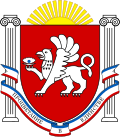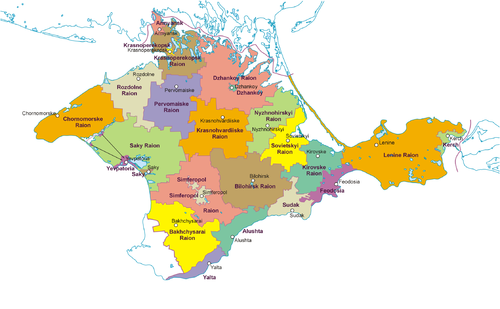Autonomous Republic of Crimea
| |
|---|---|
| Anthem: "Нивы и горы твои волшебны, Родина" (Russian) Nivy i gory tvoi volshebny, Rodina (transliteration) Your fields and mountains are magical, Motherland | |
 Autonomous Republic of Crimea within Ukraine | |
 | |
| Sovereign state | Ukraine |
| Autonomy | 12 February 1991 |
| Constitution | 21 October 1998 |
| Russian occupation | 20 February 2014 [b] |
| Annexed by Russia | 18 March 2014 [2] |
| Administrative centre | Simferopol |
| Official languages | Ukrainian, Russian, Crimean Tatar [3] |
| Ethnic groups (2001) |
|
| Government | Autonomous republic |
| Olha Kuryshko | |
| Legislature | Supreme Council (suspended) |
| Area | |
• Total | 26,100 km2 (10,100 sq mi) |
| Population | |
| 2,033,700 | |
• Density | 77.9/km2 (201.8/sq mi) |
| ISO 3166 code | UA-43 |
| NUTS statistical regions of Ukraine | UA44 |
The Autonomous Republic of Crimea is a de jure administrative division of Ukraine encompassing most of Crimea that was unilaterally annexed by Russia in 2014. The Autonomous Republic of Crimea occupies most of the peninsula, [4] [5] while the City of Sevastopol (a city with special status within Ukraine) occupies the rest.
Contents
- Background
- History
- Post-Soviet years
- Formation of the autonomous republic
- Occupation and annexation by Russia
- Demographics
- Ethnic groups and languages
- Government and administration
- Former divisions
- See also
- Notes
- References
- Further reading
- External links
The Cimmerians, Scythians, Greeks, Goths, Huns, Bulgars, Khazars, Byzantine Greeks, the state of Kievan Rus', Kipchaks, Italians, and Golden Horde Mongols [6] and Tatars each controlled Crimea in its earlier history. In the 13th century, it was partly controlled by the Venetians and by the Genoese, and in the late 15th century, it was partly under Polish suzerainty. [7] They were followed by the Crimean Khanate and the Ottoman Empire in the 15th to 18th centuries, the Russian Empire in the 18th to 20th centuries, Germany during World War II, and the Russian Soviet Federative Socialist Republic, and later the Ukrainian Soviet Socialist Republic, within the Soviet Union during the rest of the 20th century until Crimea became part of independent Ukraine with the breakup of the Soviet Union in 1991.
After the Revolution of Dignity in February 2014, Russian troops took control of the territory. [8] Russia formally annexed Crimea on 18 March 2014, incorporating the Republic of Crimea and the federal city of Sevastopol as the 84th and 85th federal subjects of Russia. [9] While Russia and 17 other UN member states recognize Crimea as part of the Russian Federation, Ukraine continues to claim Crimea as an integral part of its territory, supported by most foreign governments and United Nations General Assembly Resolution 68/262. [10]
The Autonomous Republic of Crimea is an autonomous parliamentary republic within Ukraine [4] and was governed by the Constitution of Crimea in accordance with the laws of Ukraine. The capital and administrative seat of the republic's government is the city of Simferopol, located in the centre of the peninsula. Crimea's area is 26,200 square kilometres (10,100 sq mi) and its population was 1,973,185 as of 2007. These figures do not include the area and population of the City of Sevastopol (2007 population: 379,200), which is administratively separate from the autonomous republic. The peninsula thus has 2,352,385 people (2007 estimate).
Crimean Tatars, a predominantly Muslim ethnic minority who in 2001 made up 12.10% of the population, [11] formed in Crimea in the late Middle Ages, after the Crimean Khanate had come into existence. The Crimean Tatars were forcibly expelled to Central Asia by Joseph Stalin's government. After the fall of the Soviet Union, Crimean Tatars began to return to the region. [12] According to the 2001 Ukrainian population census 58% of the population of Crimea are ethnic Russians and 24% are ethnic Ukrainians. [11] The region has the highest proportion of Muslims in Ukraine. [11]






